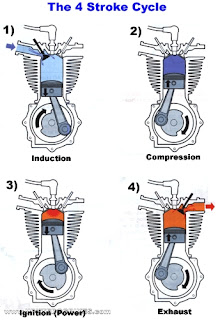As many 2-stroke and 4-stroke vehicles have already been in the motorcycling market, most of you must have already heard about them. As you may guess, it should have something to do with the number of strokes in an engine. Let us talk about it in detail.
Overview :
In my previous article, I had explained about a 4-stroke engine. I told that it works on the Otto cycle which has 4 steps. These steps are called strokes and the number of strokes defines the type of engine. There have been three major type of reciprocating engines (piston engines), namely 2-stroke, 4-stroke and 6-stroke, of which the 6-stroker is not so popular.
2-stroke Engine :
Two stokers have been used for long in automobile industry for their low weight and high power-output according to their engine displacement/cubic capacity. They have tremendous power benefits over their 4-stroke counterparts. This is due to their special engine construction and usage of a lot less internal moving parts. It doesn't has any mechanically operated valves, so it doesn't need any cam-shaft, cam-followers, timing chain, rocker arms, valves, etc. Its intake and exhaust valves are opened and closed by the up-down motion of the piston itself.
As at many times its intake and exhaust valves are opened at the same time, a considerable amount of fuel mixture is wasted, making it very inefficient. Actually a 2-stroker follows all the four steps as the 4-strokers but only in 2 strokes, i.e. in one downward and one upward motion of the piston. So, a 2-stroker will produce power after each 360degrees i.e. in one complete rotation, while a 4-stroker will produce power after each 720 degrees i.e. in two complete rotations.
Two stokers have been used for long in automobile industry for their low weight and high power-output according to their engine displacement/cubic capacity. They have tremendous power benefits over their 4-stroke counterparts. This is due to their special engine construction and usage of a lot less internal moving parts. It doesn't has any mechanically operated valves, so it doesn't need any cam-shaft, cam-followers, timing chain, rocker arms, valves, etc. Its intake and exhaust valves are opened and closed by the up-down motion of the piston itself.
As at many times its intake and exhaust valves are opened at the same time, a considerable amount of fuel mixture is wasted, making it very inefficient. Actually a 2-stroker follows all the four steps as the 4-strokers but only in 2 strokes, i.e. in one downward and one upward motion of the piston. So, a 2-stroker will produce power after each 360degrees i.e. in one complete rotation, while a 4-stroker will produce power after each 720 degrees i.e. in two complete rotations.
Advantages :
- Higher power-to-weight ratio.
- Less wastage of mechanical power.
- Intoxicatingly sweet sound(not to all).
- Ideal choice for off-road biking, motocross events and light-weight & handheld instruments, such as lawn mowers, chain saws, etc.
- Not very efficient in converting fuel's chemical energy into mechanical energy, so fuel efficiencycy is less.
- Doesn’t use sump lubrication, so a separate carburetor fed lubrication system is required.
- Very bad for environment as it produces many harmful gases, that’s why is has been banned on the streets of most parts of the world. Narrow power-band and lower torque.
- A noise pollution machine, for some.
Almost all of the automotive engines used these days, be it petrol fueled of diesel fueled, are 4-strokers. These engines, by virtue of modern technological advancements, fit to each and every application where portability is not a concern. Today’s 4-strokers can produce a lot of power, are more fuel efficient, more environment friendly, guzzle less fuel(diesel/petrol) and produce less noise as compared to their 2-stroke counterparts, so they have left only a limited areas in which 2-strokers can be used. The ever increasing cost of fuel and stricter pollution regulation norms have led to the vast development of 4-stroke engines. As I have already told about 4-stroke engines in my previous article, I won’t explain about them much.
Advantages :
- They have a broader power band and are torquier, so more practical for daily usage.
- Very efficient in converting fuel’s chemical energy into mechanical energy, so fuel efficiency is better as compared to 2-strokers.
- They use sump lubrication, so any separate carburetor fed lubrication system is not required.
- Comparatively good for environment as it produces less harmful gases and noise as compared to 2-strokers.
- Ideal choice for day-to-day usage, stunt riding, towing, race event, jet skies, ATVs, and many more.
Disadvantages :
- Comparatively lower power-to-weight ratio.
- More wastage of mechanical power.
- Uses a lot of moving parts, so maintenance cost is high.
Article by Ishan Dev




No comments:
Post a Comment